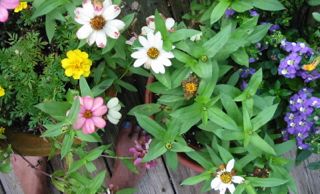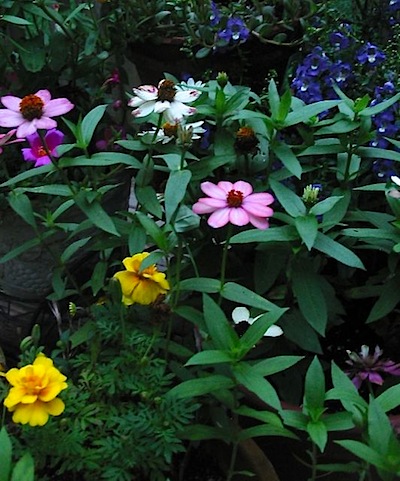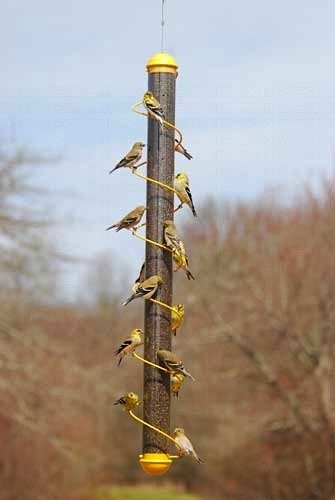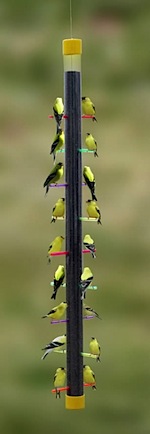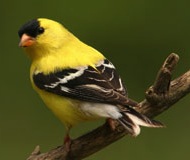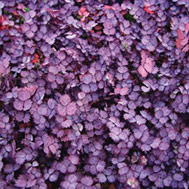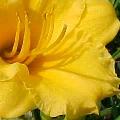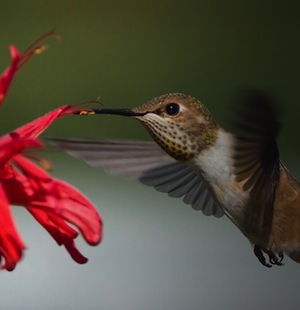-
don’t dead-head those finch feeders!
The only good thing about standing at the sink is catching the bird action on the deck! At present there’s five hummingbird feeders, two bird baths, and an open tray feeder… which squirrels usually hog. And flowers-gotta have plants and color to complete the scenery.
Hearing a rustling noise, and seeing movement in those flowers from the corner of my eye, it deserved a closer look. There were two goldfinches feeding and flitting amongst the zinnias. It was pretty cool and well worth a photo, so out on the deck I went with camera in hand. Well, the electric yellow birds didn’t make the shot… but my blue toes did 🙁
In fall, spent flowers like zinnia, coneflower, sunflower… and lots of others with seed heads provide a bounty of food for wild birds. They’re actually nature’s finch feeders. So next time you have the urge to dead-head those spent blooms… don’t! Leave them a while longer so they can do what nature intended… feed the birds.
I never did get close enough for the intended photo… but at least a better shot sans the fee
t!
-
cool spirals on these big thistle feeders
It’s a busy time for American Goldfinches as they have one of the latest breeding/nesting cycles of most backyard birds. They’re also one of very few breeds who actually molt twice a year and grow new feathers. Their electric yellow plumage is hard to miss, and most thistle feeders are seeing a good bit of traffic right now (provided the seed hasn’t gone moldy from all the rain). If yours is sitting with no takers – best to dump old seed, clean the feeder and replace with fresh thistle seed.
Innovative by design with quality construction (no cheezy plastic parts here) these 36-inch tall, large capacity thistle feeders have a cool spiral instead of perches. Featuring more feeder ports, birds really do “run the spiral” hopping from one one port to the next. This opens up space for more birds to join the party, no more waiting around for an open perch to catch some chow!
Goldfinches feed babies thistle (or nyjer) exclusively. Gross as it sounds, parents chew and prepare the tiny black seed, regurgitating it into babies’ mouths. It’s not until juveniles are out in the world that they may start to discover and eat insects. There’s a kind and quiet demeanor about this favored songbird, you’ll rarely catch them squabble at feeders. Rather than fight for a spot, most will give up and maybe try again later. Hanging a few economical thistle socks helps to alleviate this problem during peak season.
In fall when they molt again, their vibrant yellow plumage will give way to new olive drab feathers for fall and winter. It may seem like your Goldfinches have gone on their way and migrated south, but they’re still around! Keep thistle feeders out year-round to accommodate these resident birds, (and fresh water in a bath) and next summer that lemon yellow color will once again grace your yard. So popular these birds are, there’s even a birdhouse modeled after one… although typically they do nest in hedges or trees.
-
new experience with thistle feeders
“We are just learning about the appetites of the finches.
We are already out of thistle !!! But what fun !! Jan”Recently some folks in Alexandria, LA developed an interest in backyard birding. Diving right in with a suet feeder, hopper style feeder for sunflower seed, a bird bath with mister (for summer) and two thistle feeders, the timing couldn’t have been better – for the birds and for them to witness the amazing flurry of activity this pre-spring season.
By her note above, we’re gathering they’ve got flocks of pine siskins and goldfinches in the yard right now, we sure do here in North GA.! For months thistle feeders sat, with seed going bad due to lack of activity. Then out of nowhere… tons of birds chowing down on thistle!
Also called Nyjer, thistle’s other nickname among many is “black gold” because it’s not a cheap seed to offer. A bit on the pricey side, it does have the benefit of being a non-germinating seed, one of very few seeds that won’t sprout weeds. But it’s about the only food adults will feed chicks in summer, so extra feeders (like thistle socks) and lots of seed greatly helps goldfinches thrive and flourish during their late breeding season (June and July).
Being new to the birding scene, Jan had the right idea in mind when she inquired about creating a welcoming and bird-friendly habitat in their yard. No single feeder, house, or birdbath will attract as many song birds as an overall habitat with natural food sources and shelter. And since we’re in the same planting zone, it was fairly easy to come up with a few suggestions too. Rather than re-word, and re-type the email, here’s our thoughts on cre
ating an attractive and wildlife-friendly environment.
“OK, did some research and thinking of my own yard… here are some suggestions:
Overall: Mature trees and Shrubs are very good for attracting all winged friends as not only a food source, but shelter. Since this is an open area, I’m thinking your yard must have mature trees along the back/sides? Many birds nest in trees and shrubs as they’re not all considered “cavity-dwellers” (birdhouse users).
If you’d like some kind of height or focal point around the new area, Butterfly Bush, Viburnum, Mimosa, or a Crab Apple is a great choice. These are hearty, and provide both shelter and food (nectar or fruit). Any of the native berry-producing shrubs will also provide a great food source.
Using pots for annuals is always a great option too, for color, nectar and seeds in fall!
Petunias, Zinnias, and various salvias; most garden center plants now have tags depicting if the plants provide a food source, so just look around. There should be lots of options here! You can even save seeds in the fall for replanting in spring.Cardinals, chick
adees, finches and titmice will eat seeds of many plants. The trick is not to dead-head them in fall when the urge strikes! There are lots of perennials that fit the bill in this category: coneflower, coreopsis, seedum, black-eyed susan, goldenrod, sunflowers, mexican sunflower, native salvia-(very good), coral bells,. Again look around at the garden center, and if you’re lucky… you’ll find an employee with some knowledge on the subject!
As far as for ground cover: I think mulching the area and adding plants is a better option than a solid ground cover. You’ll want to be able to get to the feeders, bath, mister and “parts” of the landscape without stepping all over things. Also, spilled seed may sprout weeds, and it’s easier to control that if not covered solid with growth.
Day lilies are a good choice, the Stella de Oro’s are quite hearty and pretty! If you wanted something more low-growing that spreads, (full sun) try purple sheep’s burr, also called purple goose leaf. In fact this would be a beautiful contrast with yellow lilies! The Stella variety tends to stay more compact as opposed to some which grow taller and appear “lanky”. Never, ever plant creeping strawberry, or ivy…these are the bane of my existence in parts of my yard 🙁 They are also a wonderful habitat for snakes, especially if you’ll have the mister going when it’s warm!
Native salvia: I’ve got a bed of this which provides color from spring through fall. Vibrant red, there are always
hummingbirds and butterflies hovering. It’s actually below one of the misters, and does well with the “extra water”. Extremely hearty, it multiplies each year, spreading roots, but does tend to grow taller, more of a back-drop. Lantana would also be a good choice if you’ve got the space for it to grow. I love perennials!
It may be helpful to actually sketch out the area on paper before planting. Drop in the plant names to get an idea. You can always do search for pics to get an idea too!
Okay… hope this helps, and as always, feel free to ping me back with questions”

